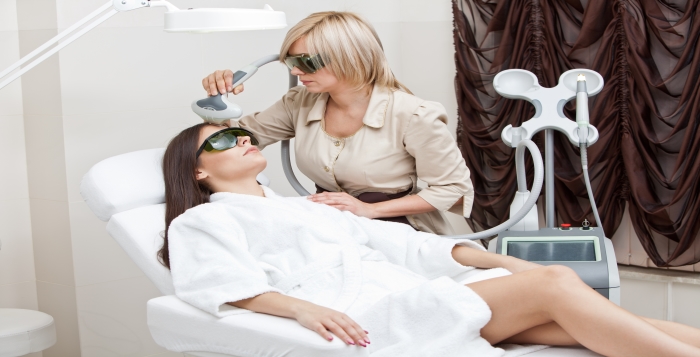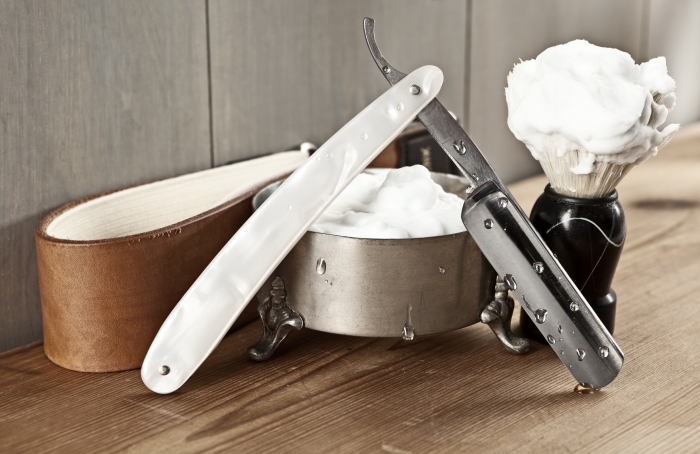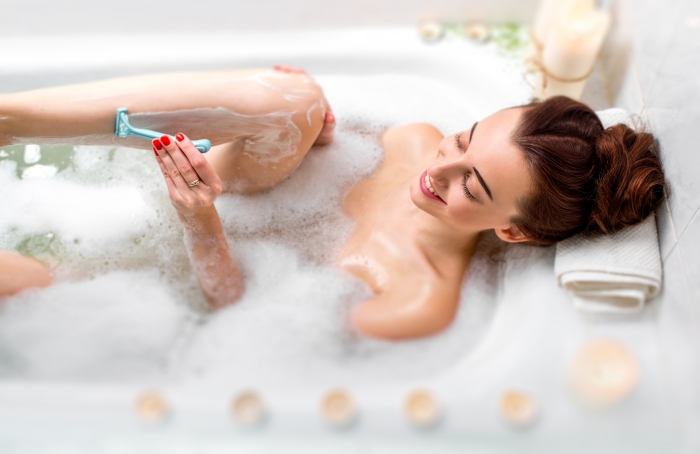If you’re sick of all the sites out there telling you to rub papaya paste and lemon juice on your face to remove unwanted hair, you’ve come to the right place! I’m going to tell you everything I can about the most reliable ways to actually get rid of unwanted hair on every part of your body. Continue reading and you’ll learn all about the most reliable methods, tips for getting the best results possible and the positives and downsides of each hair removal process.
1. Shaving
Shaving is by far the most common method of hair removal. It’s easy, convenient, fast and works equally well on thick hair as it does on the finer hair found on the legs.
Shaving Tips:
 • A close shave that doesn’t result in nicks, cuts, bumps and dry skin starts with a good razor. Look for a razor with 4 or more blades to reduce irritation and the amount of passes needed to remove all the hair. A pivoting head is also a good feature, particularly for the legs.
• A close shave that doesn’t result in nicks, cuts, bumps and dry skin starts with a good razor. Look for a razor with 4 or more blades to reduce irritation and the amount of passes needed to remove all the hair. A pivoting head is also a good feature, particularly for the legs.
• Replace your blades every 5 – 7 shaves. More often if you have thick hair.
• Don’t waste your money on “female shave cream” unless they’re cheap. Shaving creams are all the same for the most part, whether male or female, and the truth is that most of them end up sucking the moisture out of your skin anyway.
• Rub baby oil, olive oil, or coconut oil on the area you’re going to shave before getting in the shower. Oil repels water so it won’t wash off until you clean it with soap, making for great waterproof lubrication. This step will also help to pre-soften the hair and block natural moisture from escaping.
Positives of Shaving:
• Fast.
• Easy.
• Can be done at home.
Downsides of Shaving:
• Possible irritation like dry skin, cuts, bumps, rashes and ingrown hairs.
• Hair starts growing back within hours after you’ve finished – resulting in rough, stubbly skin.
• Cost of replacing blades can really add up.
2. Tweezing
Tweezing is a necessary evil sometimes. This hair removal method is most popular for the eyebrows and for unsightly facial hair. It’s a great method for areas where you want to carefully remove only a few hairs.
Tweezing Tips:
 • Avoid tweezers with pointy ends that have little surface area to actually grab the hair. A good pair of tweezers will have a ¼ inch wide end with a slanted tip for easily grabbing hairs.
• Avoid tweezers with pointy ends that have little surface area to actually grab the hair. A good pair of tweezers will have a ¼ inch wide end with a slanted tip for easily grabbing hairs.
• Alway tweeze after (or in, if you prefer) a warm shower. Warm water opens up and softens the follicle, making the hair slip out easier.
• Pull in the direction that the hair grows naturally to avoid ripping or stretching the follicle, which will result in bumps and redness.
• If you find tweezing really painful, dab some Oragel or other numbing agent on the area you’ll be working on a few minutes before you begin plucking.
• Rub a dab of mild hydrocortisone cream on the area right after plucking to reduce irritation.
Positives of Tweezing:
• Hair remains gone for weeks.
• Inexpensive. You only have to buy tweezers once and they can be used forever.
• Can be done at home.
Downsides of Tweezing:
• It’s difficult to pull the hair out without breaking it above the root.
• Can cause ingrown hairs.
• PAIN!
3. Waxing
Waxing is another quite popular method for getting rid of hair from the comfort of your own home. It’s also affordable for most people to have a professional wax them at a salon.
Waxing Tips:
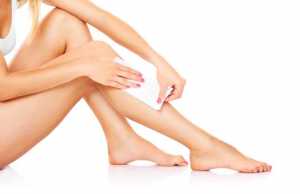 • Use an exfoliating scrub the day before you wax. Don’t do it any sooner than 12 hours beforehand or more irritation may occur.
• Use an exfoliating scrub the day before you wax. Don’t do it any sooner than 12 hours beforehand or more irritation may occur.
• Avoid alcohol, drugs or caffeine prior to waxing – stimulants tighten the pores.
• Trim the hair to one-eighth of an inch. Too short and the wax won’t grip, too long and you run the risk of breaking the hair above the follicle instead of pulling it out.
• Heat the wax only to the temperature recommended on the label, use a digital or mercury thermometer to check. Too hot and you’ll quickly regret it!
• Immediately apply an after wax moisturizer to the area to reduce irritation, then apply some mineral oil generously to the area about 30 minutes after.
Positives of Waxing:
• Hair stays gone for weeks and less hair grows back every time you wax.
• Relatively inexpensive, particularly if using a home waxing kit.
• Works on any part of the body with equal effectiveness.
Downsides of Waxing:
• A very real potential for redness, irritation and even infection around the hair follicles.
• Long prep time heating the wax, applying it and then lots of clean up with strips and wax dripping everywhere.
• PAIN! It doesn’t matter how good you or they (salons) are, waxing just plain hurts every time.
4. Depilatory Products
Depilatory creams are also quite popular for removing unsightly hair. They can be used comfortably on most areas of the body.
Tips for Using Depilatory Products:
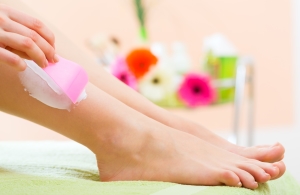 • Buy a brand with a good reputation. Read reviews and look for comments about your hair type (ie., thin, thick, curly, straight).
• Buy a brand with a good reputation. Read reviews and look for comments about your hair type (ie., thin, thick, curly, straight).
• Don’t use body/bikini depilatories on your face and don’t waste your time using facial depilatories on your body hair. Those made for leg, underarm and pubic hair have a higher concentration of chemicals.
• Follow the instructions carefully, even airing on the side of caution for your first time using a new product and rubbing it off earlier than recommended. Burns from leaving the cream on too long can take hours to appear and days to heal.
Positives of Using Depilatory Products:
• Hair stays gone for up to a week.
• Fast and easy.
• Inexpensive.
Downsides of Using Depilatory Products:
• Timing is crucial to maximize hairs removed while avoiding painful skin burns.
• The smell of most products are absolutely terrible.
• PAIN! This is the price we pay to avoid razor stubble, right?
5. Threading
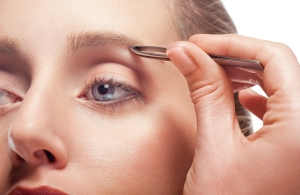 Threading is a pretty unconventional hair removal method for most Americans and Europeans, but is very common in many parts of the Middle East and China. Threading is best used for shaping the thick hairs of the eyebrows and bikini line, but not time-practical for large scale hair removal.
Threading is a pretty unconventional hair removal method for most Americans and Europeans, but is very common in many parts of the Middle East and China. Threading is best used for shaping the thick hairs of the eyebrows and bikini line, but not time-practical for large scale hair removal.
For tips on how to thread your own hair at home, refer to this in-depth tutorial:
http://www.beautyhows.com/eyebrow-threading-tips
Positives of Threading:
• Inexpensive.
• Easier to fine-tune the shape of eyebrows over waxing.
• Works perfectly on people with oily skin who find it hard to get the wax to stick to their hair.
Downsides of Threading:
• It’s a technique that has to be learned and refined. Can be difficult for people lacking in coordination to master.
• Hard to find a salon that offers it as a service, if you can’t or don’t want to try it yourself.
• Can burn the skin if not done properly.
6. Laser Treatment
For the most part, laser treatments should always be done by professionals. At-home lasers are available but most have several complaints surrounding their effectiveness and the cheap <$1000 units are absolutely garbage in most cases.
Laser Hair Removal Tips:
 • Wait around 4 weeks to book an appointment after waxing, tweezing or using a depilatory cream. Some hairs go dormant for longer periods, and you want the Technician to zap the most amount of hairs per visit as possible to avoid costly followup visits.
• Wait around 4 weeks to book an appointment after waxing, tweezing or using a depilatory cream. Some hairs go dormant for longer periods, and you want the Technician to zap the most amount of hairs per visit as possible to avoid costly followup visits.
• Shave the area with a clean razor the day before your appointment. This might seem counterintuitive considering the tip above, but the laser will be able to locate each follicle easier when the thickest portion of the hair shaft is exposed.
• Use the moisturizing cream recommended by your Laser Technician. Follow the application schedule they give you and don’t skip any.
• Avoid skin exposure in the week following your appointment.
• Try to book your followup appointments at least 6 weeks after a treatment.
Positives of Laser Hair Removal:
• It’s permanent. After the 4 – 5 initial procedures, very little if any hair will ever grow back.
• It’s easy, since you’re laying in a chair with someone else doing all the work for you.
• Over all, laser hair removal results in less irritation of the skin long-term, since it has to be repeated rarely, if ever once the hair is zapped and gone.
Downsides of Laser Hair Removal:
• Minor irritation during the procedure (often referred to as a “zapping” feeling on the skin).
• Can cause burning and may lead to infection if post-procedure moisturizing instructions aren’t followed.
• It’s expensive, costing well over $100 per session, with several followup visits required for complete removal.
7. Electrolysis
This is yet another hair removal method that’s best left to the professionals. At-home electrolysis machines don’t offer permanent hair removal because at-home users find it difficult or impossible to insert the needle used to zap the hair directly into the follicle, where it needs to go in order to kill it. However, that being said, many women have a lot of success using their at-home units; it’s all a matter of equipment, practise, and
patience.
Electrolysis Tips:
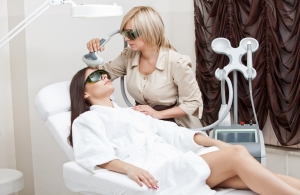 • Make sure to have a shower before going for the procedure or performing it yourself at home. Consider that a “needle” is going to lightly pierce each individual hair follicle in the area where the removal is taking place. The chance of infection is increased ten-fold with this method over others.
• Make sure to have a shower before going for the procedure or performing it yourself at home. Consider that a “needle” is going to lightly pierce each individual hair follicle in the area where the removal is taking place. The chance of infection is increased ten-fold with this method over others.
• Also, use an exfoliating scrub to ensure there’s minimal dead skin cells on the surface of the area being done.
• Don’t use any skin creams or perfumes after showering. Again, infection is a big reality with electrolysis treatments.
• It is a painful procedure, consider taking an Advil or two Tylenol before the procedure.
• This is one of the most physically and mentally demanding hair removal methods. Ask your Electrologist if they need a break or two during the procedure, take breaks when offered as it’s likely their way of saying “I need a rest.”
• Be patient with your expectations. It can take up to a year and a half of monthly treatments to fully eliminate all the hair.
Positives of Electrolysis:
• It’s permanent for the most part. Once a month goes by without any hair growth, you can pretty much expect to never see any hair again.
• Electrolysis is by far much cheaper than Laser; the only other permanent hair removal method.
• Can also be done on the eyebrows, while Laser Technicians aren’t able to safely get close to this area.
Downsides of Electrolysis:
• Takes several more appointments for complete hair removal than laser. Lasers take 4 – 5 visits spaced 6 weeks apart. Electrolysis can take up to a year and a half of monthly visits.
• Strong possibility of infection, if you don’t clean yourself well before the procedure or the technician uses dirty equipment. Reputation of the facility you use is crucial to avoid infection and/or disease.
• PAIN! Sorry, I can’t be less blunt with using this word. Not everyone feels pain during all the procedures I’ve detailed, but for the most part, you will feel it. The good news is that the pain does dull after a few minutes for most people.
Recap:
I hope you’ve found this post informative.
Which method you choose really depends on your preference:
• Some women find a razor works just fine for them, but of course the hair doesn’t stay away for very long either.
• Tweezing and threading are great for fine-tuning the eyebrows or bikini line.
• Depilatory creams work, are effective at removing hair anywhere on the body and give you a smooth silky finished result, as long as you don’t torch your skin by leaving the cream on too long!
• Laser and electrolysis both offer the same advantages of eventual permanent removal. Laser is faster but more expensive. Electrolysis costs less overall but will require more lengthy office visits to achieve permanent results.
Thanks for stopping by. Don’t hesitate to leave any questions/comments in the space provided below.

